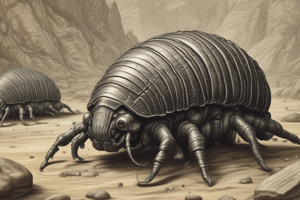Podcast
Questions and Answers
¿Qué característica única comparten los artrópodos según el texto?
¿Qué característica única comparten los artrópodos según el texto?
- Ausencia de extremidades articuladas
- Presencia de un esqueleto interno
- Presencia de un caparazón compuesto principalmente de calcio
- Segmentación del cuerpo y articulaciones en las extremidades (correct)
¿Qué grupo de artrópodos extintos se destaca en el texto?
¿Qué grupo de artrópodos extintos se destaca en el texto?
- Miriópodos
- Crustáceos
- Arácnidos
- Trilobitomorfos (correct)
¿Cuál era una característica distintiva de los trilobites?
¿Cuál era una característica distintiva de los trilobites?
- Forma redondeada sin segmentación visible
- Caparazón interno
- Tres regiones claramente definidas: cefalón, tórax y pigidio (correct)
- Alas para vuelo
¿Cómo crecían los trilobites según el texto?
¿Cómo crecían los trilobites según el texto?
¿Cuál era una de las adaptaciones alimentarias de los trilobites mencionada en el texto?
¿Cuál era una de las adaptaciones alimentarias de los trilobites mencionada en el texto?
¿Cuál era el tamaño máximo alcanzado por los trilobites según el texto?
¿Cuál era el tamaño máximo alcanzado por los trilobites según el texto?
¿Cuál es una característica distintiva de los trilobites dentro del Phylum Trilobitomorpha?
¿Cuál es una característica distintiva de los trilobites dentro del Phylum Trilobitomorpha?
¿Qué función cumplía el exoesqueleto de los trilobites?
¿Qué función cumplía el exoesqueleto de los trilobites?
¿En qué era se desarrollaron y prosperaron los trilobites según el texto?
¿En qué era se desarrollaron y prosperaron los trilobites según el texto?
¿Qué tipo de apéndices poseían los trilobites?
¿Qué tipo de apéndices poseían los trilobites?
¿Qué proceso único experimentaban los artrópodos durante su crecimiento, incluyendo los trilobites?
¿Qué proceso único experimentaban los artrópodos durante su crecimiento, incluyendo los trilobites?
¿Cómo se caracterizaban los trilobites según el texto?
¿Cómo se caracterizaban los trilobites según el texto?
¿Qué papel han desempeñado los trilobites en la paleontología según el texto?
¿Qué papel han desempeñado los trilobites en la paleontología según el texto?
¿Qué tipo de evolución representan los trilobites según el texto?
¿Qué tipo de evolución representan los trilobites según el texto?
¿En qué época geológica se extinguieron los trilobites según el texto?
¿En qué época geológica se extinguieron los trilobites según el texto?
¿Qué importancia tienen los trilobites en la bioestratigrafía según el texto?
¿Qué importancia tienen los trilobites en la bioestratigrafía según el texto?
Flashcards are hidden until you start studying
Study Notes
Arthropods are a diverse group of animals that dominate the animal kingdom, with an estimated 85 percent of known species belonging to this phylum. The name "arthropoda" means "jointed legs," and it accurately describes the many invertebrates that are included in this phylum. Arthropods showcase several unique features, including segmentation of the body and fusion of sets of segments that give rise to functional body regions called tagma, an exoskeleton made principally of chitin, and jointed appendages.
One of the most well-known groups of extinct arthropods is the Trilobitomorpha, which includes trilobites. Trilobites were marine arthropods that first appeared during the Cambrian period and dominated the seas until their extinction in the Permian period. These animals were recognized by their distinctive three-lobed, three-segmented form. Trilobites were segmented and divided into three regions from head to tail: the cephalon, thorax, and pygidium. They had an external skeleton, or exoskeleton, composed of chitinous material, which allowed them to grow by shedding their exoskeletons during a process called ecdysis.
Trilobites were adapted to various feeding habits and lifestyles. Some were active predators, while others were scavengers, and some probably ate plankton. The largest trilobites, such as Paradoxides harlani, could grow to be over 45 cm (18 inches) in length and may have weighed as much as 4.5 kg (10 pounds).
Although trilobites are now extinct, they provide valuable insights into the evolution of arthropods. Their fossilized remains have been found in various geological periods, and their study has contributed significantly to biostratigraphy, paleontology, evolutionary biology, and plate tectonics.
In conclusion, the phylum Arthropoda encompasses a vast array of animals, including trilobites, which were once a dominant group of marine arthropods. Despite their extinction, the study of trilobites continues to provide valuable information about the evolution of arthropods and their role in the biosphere.
Studying That Suits You
Use AI to generate personalized quizzes and flashcards to suit your learning preferences.




